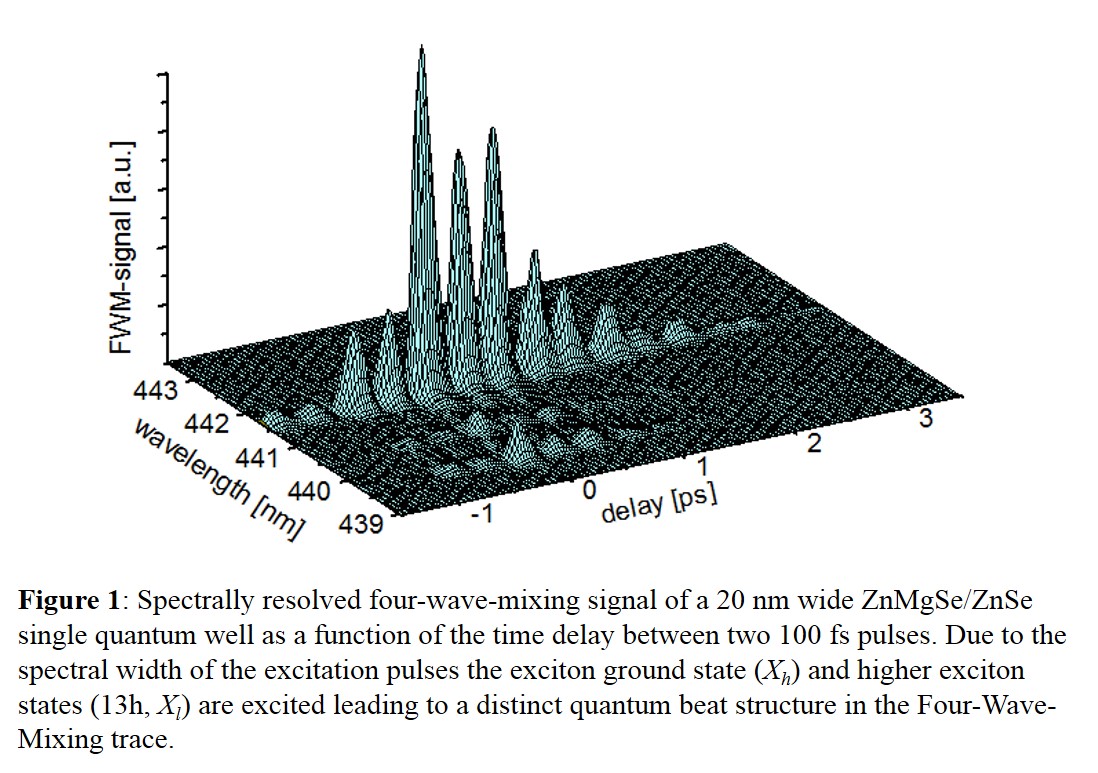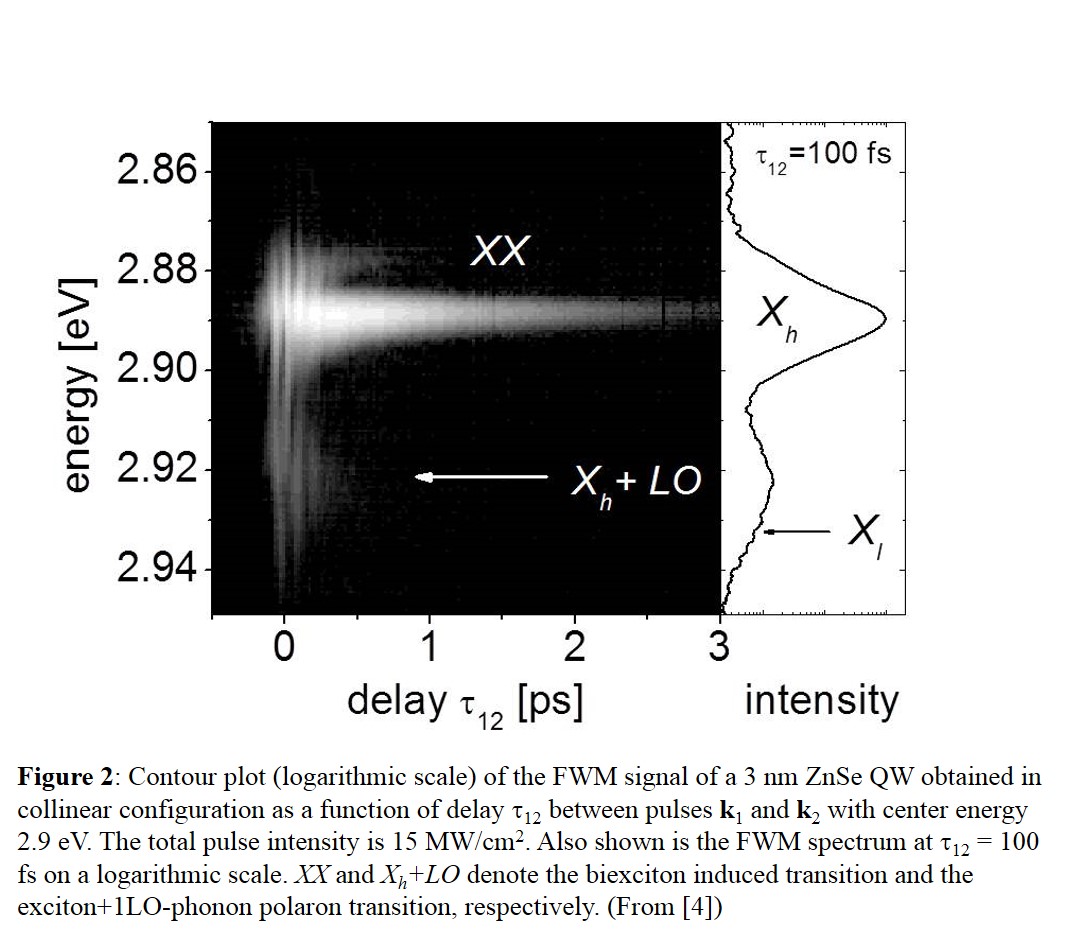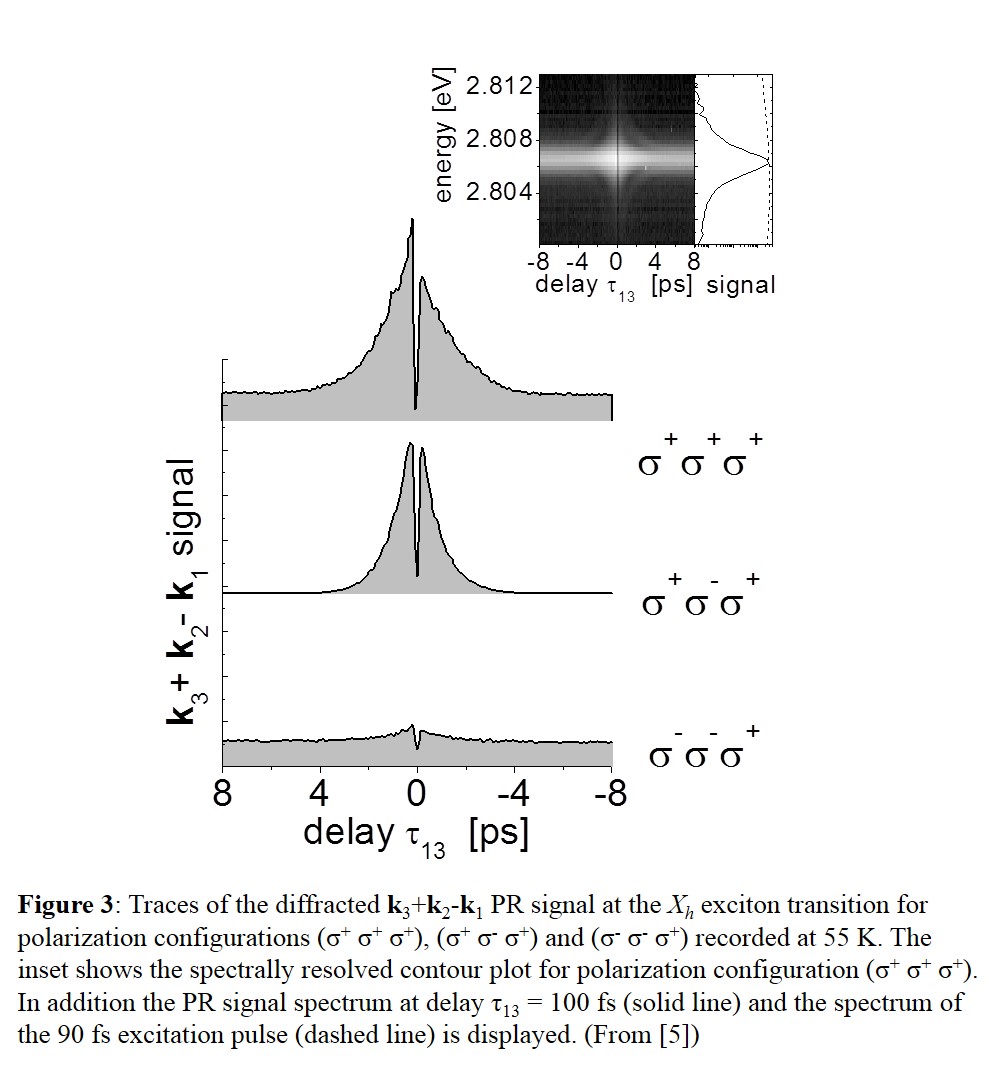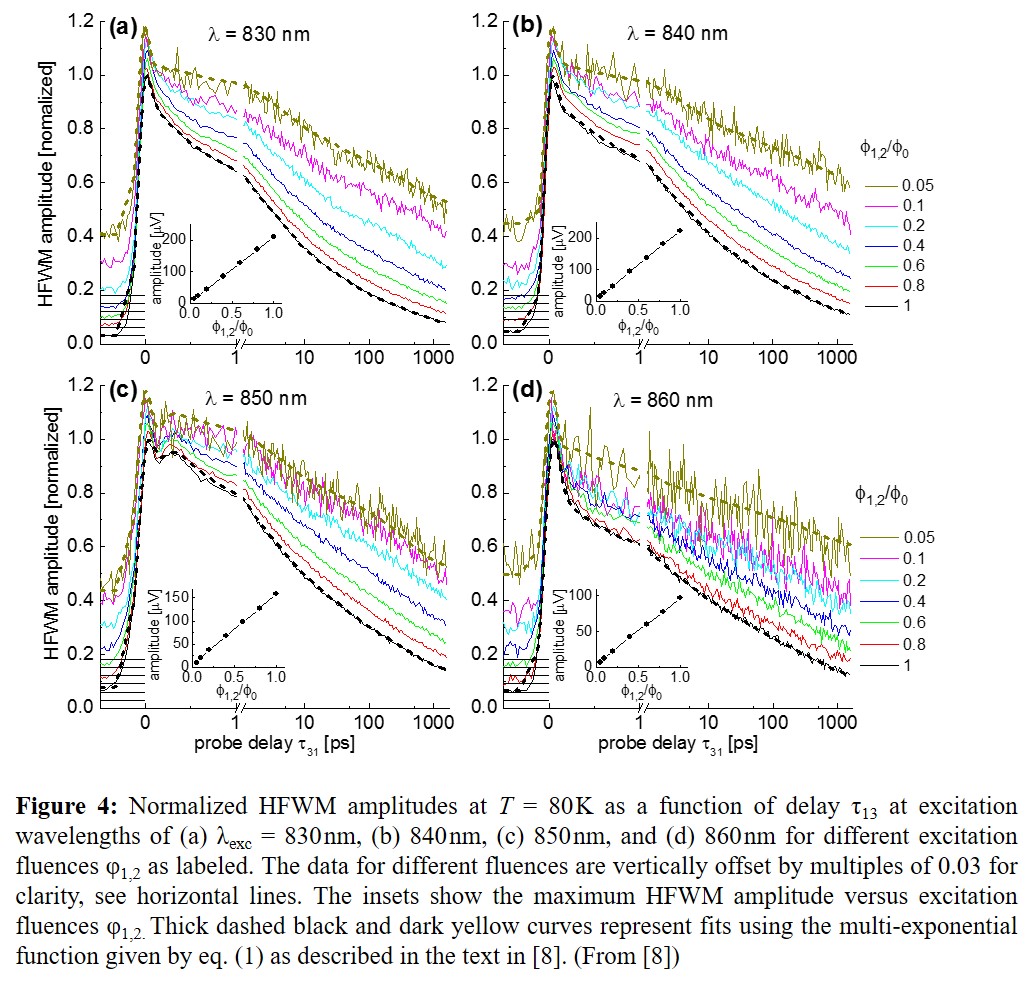Ultrafast Relaxation Dynamics in Semiconductor Nanostructures and Nanowires
Coherent processes in semiconductor nanostructures
The optical excitation of electronic states in semiconductor nanostructures (quantum wells1, -wires2 and – dots3) leads to the formation of quasi-particles showing quantum coherent phenomena on a (sub-)picosecond time scale (see Fig. 1). The ultrafast spectroscopic method of degenerate Four-Wave-Mixing with a time resolution down to 10 fs represents a powerful tool to study these coherent processes and its quantum kinetics.

1H. P. Wagner, S. Tripathy, Dephasing of coherences between σ+ and σ- exciton states in a ZnSe quantum well, Phys. Rev. B 69, 125325 (2004).
2H. P. Wagner, H.-P. Tranitz, R. Schuster, G. Bacher, A. Forchel, Biexciton binding energy and exciton-LO-phonon scattering in ZnSe quantum wires, Phys. Rev. B 63, 155311 (2001).
3H.-P. Tranitz, H. P. Wagner, R. Engelhardt, U.W. Pohl, D. Bimberg, Thermal redistribution and dephasing of localized excitons in CdSe/ZnSSe quantum dot structures, Phys. Rev. B 65, 35325 (2002).
Coherent exciton-LO-phonon polarons in ZnSe QWs with strong confinement
We discovered coherent exciton-LO-phonon polarons in a 3 nm ZnSe single quantum well using four-wave mixing with 30 fs light pulses. The formation of these superposition states is attributed to a strong LO-phonon coupling by the Fröhlich interaction in a system in which the exciton binding exceeds the LO-phonon energy. The rapid decay of these coherent quasiparticles is attributed to the disintegration into zero-phonon excitons and free LO-phonons as well as to the inhomogeneous broadening of LO-phonon energies due to disorder and k-space dispersion (see Fig. 24).
This work was supported by NSF Grant DMR-0305076 Electron-LO-Phonon Quantum Kinetics in Wide-Gap II-VI Nanostructures with Strong Confinement

4Reprinted with permission from S. Tripathy, H. P. Wagner, A. Ueta, and D. Hommel, Coherent Exciton-LO-Phonon Polarons in ZnSe Quantum Wells with Strong Confinement, Phys. Rev. B 75, 245316 (2007), Copyright 2007, The American Physical Society.
Phase coherent photorefractive (PCP) effect in ZnMgSe/ZnSe single QWs
We discovered a novel exciton resonant all-optical photorefractive effect in ZnSe/ZnMgSe single QWs grown on GaAs substrate using ultrashort 90 fs and 30 fs laser pulses. The effect is attributed to the formation of an electron grating within the QW induced by the interference of coherent excitons that preserve phase and polarization of the incident light field (see Fig. 35). This new effect opens new design possibilities for data storage, computational applications, and coherent imaging 6,7. The current diffraction efficiency is η ≈ 5 x 10-4 in not optimized samples. The efficiency increases with increasing conduction band offset between QW and barrier material7. Currently we are investigating the exciton dynamics and electron built-up times in improved QW samples with higher diffraction efficiencies.
This work was partially supported by NSF Grant DMR-0305076 Electron-LO-Phonon Quantum Kinetics in Wide-Gap II-VI Nanostructures with Strong Confinement

5Reprinted with permission from H. P. Wagner, S. Tripathy, H.-P. Tranitz, W, Langbein, Phase coherent photorefractivity in ZnSe single quantum well, Phys. Rev. Lett. 94, 147402 (2005), Copyright 2007, The American Physical Society.
6H. P. Wagner, S. Tripathy, P. Bajracharya, H.-P. Tranitz, Spectral and thermal dependence of exciton induced photorefraction in ZnSe single quantum wells, Phys. Rev. B 73, 085318 (2006).
7A. Kabir, H. P. Wagner, Influence of electron density and trion formation on the phase-coherent photorefractive effect in ZnSe quantum wells, Phys. Rev. B 83, 125305 (2011).
Population dynamics and dephasing of excitons in semiconductor nanowires
We investigated the dephasing and population dynamics of electron-hole (e-h) pairs and excitons in vapor-liquid-solid grown polytype wurtzite/zincblende (WZ/ZB) InP nanowires (NWs)8 and zincblende AlGaAs/GaAs shell-core NWs (to be published) using heterodyne four-wave-mixing (HFWM) in three-beam configuration. For the InP NWs the photon energy of the 100 femtosecond excitation pulses was varied to predominantly excite either mobile excitons and e-h pairs or indirect WZ/ZB excitons. The population dynamics reveals a multi-exponential decay with time constants ranging over six orders of magnitude. The dynamics has been interpreted by a coupled rate equation model which considers wurtzite and zincblende electron states, donor electron states, and band bending trapping holes to the surface. The model reproduces the essential features of the experimentally observed dynamics at different excitation energies, fluences, and lattice temperatures (ranging from 80 to 270 K). Intraband thermalization is reached within 5-50 ps, after which the non-radiative recombination dominates the dynamics. Notably, the screenable surface band bending results in long lived spatially separated carriers, causing a photo-generated, spatially separated electron and hole density which is controlling the long-lived dynamics.

8Reprinted with permission from H. P. Wagner, M. Kaveh, Q. Gao, H. Tan, C. Jagadish, W. Langbein, Population dynamics of excitons and electron-hole pairs in polytype wurtzite/zincblende InP nanowires, Phys. Rev. B 95, 045305, (2017), Copyright 2017, The American Physical Society.
